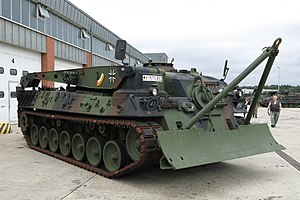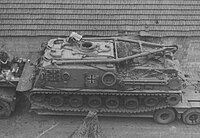Bergepanzer 2
| Bergepanzer 2 | |
|---|---|
 Bergepanzer 2 of the German Army | |
| Type | Armoured recovery vehicle |
| Place of origin | West Germany |
| Service history | |
| In service | 1966–present |
| Used by | See Operators |
| Production history | |
| Designer | |
| Designed | 1960s |
| Manufacturer | |
| Unit cost | DM 750.000 (1966) |
| Produced | 1966–1978 |
| No. built | 742 |
| Variants | See Variants |
| Specifications | |
| Mass | 39.8 tonnes (43.9 short tons) 2A2: 40.6 tonnes (44.8 short tons) |
| Length | 7.68 metres (25.2 feet) |
| Width | 3.25 m (10.7 ft) |
| Height | 2.69 m (8.8 ft) (crane boom retracted) |
| Crew | 4 |
| Armor | Steel: 10–40 mm RHAe |
Main armament | 2×7.62 mm MG3 |
Secondary armament | Smoke discharger |
| Engine | MTU MB 838 CaM 500, 10-cylinder, 37.4 litres, multi-fuel engine 830 PS (820 hp) (2.86 kNm, 610 kW) |
| Power/weight | 20.9 PS/t (20.6 hp/t) 2A2: 20.4 PS/t (20.1 hp/t) |
| Transmission | ZF Friedrichshafen 4 HP-250 |
| Suspension | Torsion bar suspension |
| Fuel capacity | 1,550 litres (341 imperial gallons; 409 US gallons) 2A1: 1,410 litres (310 imperial gallons; 372 US gallons) |
Operational range | 850 km (530 mi) |
| Maximum speed | 62 km/h (39 mph) |
The Bergepanzer 2 is an armored recovery vehicle based on the Leopard 1 main battle tank, developed in the 1960s and manufactured by Atlas-MaK Maschinenbau for the West German army. It first entered service in 1966 and replaced the earlier Bergepanzer 1. Various versions have served in the armed forces of Germany and other countries. It was later succeeded by the Bergepanzer 3 "Büffel".
History

The West German rearmament from the mid-1950s led to the initial equipping of the Bundeswehr with U.S. armored vehicles. In addition to M47 and M48 Patton main battle tanks, M74 armored recovery vehicles were introduced, which, from 1962, were replaced by the M88 Recovery Vehicle, designated "Bergepanzer 1".[2]: 2
Development
The Leopard 1 was designed from the outset as a family of vehicles. This was intended to significantly reduce the cost of operating, maintaining and repairing the tracked vehicles, since the personnel for many areas only required one-off training and the assemblies could be easily replaced.
Right after the Leopard, the armored recovery vehicle 2 was tackled. "Its main task is to recover or, as far as possible, repair on the spot tanks that have broken down on the battlefield due to enemy action or technical damage."[3]
On September 9, 1966, the first Bergepanzer Standard rolled off the production line at MaK Kiel.[3]
Variants
WiSENT 1
FFG offers the WiSENT in 3 different variants, the WiSENT 1 ARV, the WiSENT 1 AEV and the WiSENT 1 Mine Clearing.[4]
Technical data
| Description | Bergepanzer 2[2] | Bergepanzer 2A1/Pionierpanzer 1 | Bergepanzer 2A2[2] | Bergepanzer "Wisent" | ||||||
|---|---|---|---|---|---|---|---|---|---|---|
| Type: | Armored recovery vehicle with self-supporting hull, turretless superstructure and crane boom | |||||||||
| Crew: | 4 | |||||||||
| Engine: | MTU MB 838 CaM 500, 10-cylinder, 37.4 litres, multi-fuel engine | |||||||||
| Displacement: | 37.400 cm³ | |||||||||
| Power output: | 610 kW (830 PS) | 706 kW (960 PS) 3300 Nm at 1600 min−1 | ||||||||
| Cooling: | Thermostatically controlled axial fan | |||||||||
| Transmission: | ZF 4 HP-250 planetary gearbox with four forward and two reverse gears | |||||||||
| Suspension system: | Torsion bar spring mounted support roller drive | Torsion bar spring mounted support roller drive with hydraulic dampers | ||||||||
| Overall length: (Clearing blade in driving position) |
7570 mm | 7980 mm | 7680 mm | 8210 mm | ||||||
| Overall width: | 3250 mm | |||||||||
| Overall height: | 2695 mm | 2970 mm (with topcase) | ||||||||
| Ground clearance: | 440 mm | |||||||||
| Wading depth without preparation: | 1200 mm | |||||||||
| Wading depth with wading snorkel: | 2250 mm | |||||||||
| Underwater driving depth w. underwater snorkel: | 4000 mm | |||||||||
| Trench passability: | 2500 mm | |||||||||
| Climbing ability: | 1150 mm | 880 mm | 1000 mm | 880 mm | ||||||
| Gradeability: | 60 % | |||||||||
| Cross slope capability: | 30 % | |||||||||
| Empty weight: | 39.200 kg | 40.200 kg | 39.980 kg | 47.000 kg | ||||||
| Combat weight: | 39.800 kg | 40.800 kg | 40.600 kg | 54.000 kg (max. 56.000 kg) | ||||||
| Maximum speed: | 62 km/h | |||||||||
| Fuel capacity: | 1550 l | 1410 l | 1550 l | – | ||||||
| Fuel consumption and operating range (road): | 840 km at 165 l/100 km | 650 km at 165 l/100 km | 840 km at 165 l/100 km | – | ||||||
| Fuel consumption and operating range (terrain): | 400 km (2A1) bis 500 km at 300 l/100 km (Consumption above 400 l/100 km is not uncommon in towing operations) | – | ||||||||
| Turning radius: | 496 cm | |||||||||
| Clearing blade width: | 3250 mm | 3250 mm (3750 mm with increased width blade) | 3250 mm | 3250 mm (3750 mm with increased width blade) | ||||||
| Clearing blade height: | 591 mm | 995 mm | 591 mm | 995 mm | ||||||
| Armament: | 2 × 7.62×51mm NATO MG3 or C6 GPMG as anti aircraft gun and front gun, smoke discharger | smoke discharger, armament varies depending on user | ||||||||
| Ammunition: | 4250 cartridges pverall for both MG3 | – | ||||||||
Operators

Current operators
 Brazil – Brazil operates a least 1 BPz-2 as of 2021.[5]: 398
Brazil – Brazil operates a least 1 BPz-2 as of 2021.[5]: 398  Chile – Chile operates 35 BPz-2 as of 2021.[5]: 402
Chile – Chile operates 35 BPz-2 as of 2021.[5]: 402  Denmark – Denmark operates 10 BPz-2 and 6 WiSENT 1 as of 2021.[5]: 97
Denmark – Denmark operates 10 BPz-2 and 6 WiSENT 1 as of 2021.[5]: 97  Estonia – Estonia operates 2 BPz-2 as of 2021.[5]: 98
Estonia – Estonia operates 2 BPz-2 as of 2021.[5]: 98  Finland – Finland operates 9 BPz-2 as of 2021.[5]: 100
Finland – Finland operates 9 BPz-2 as of 2021.[5]: 100  Germany – Germany operates 82 BPz-2 as of 2021.
Germany – Germany operates 82 BPz-2 as of 2021.
- Army – 59 [5]: 107
- Joint Support Service – 23 [5]: 108
 Greece – Greece operates 43 BPz-2 as of 2021.[5]: 110
Greece – Greece operates 43 BPz-2 as of 2021.[5]: 110  Italy – Italy operates 137 BPz-2 as of 2021.[5]: 117 MaK originally delivered 69 BPz-2 and 12 Pionierpanzer. The Italian company OTO Melara produced another 68 Bergepanzer 2 under license.[1]
Italy – Italy operates 137 BPz-2 as of 2021.[5]: 117 MaK originally delivered 69 BPz-2 and 12 Pionierpanzer. The Italian company OTO Melara produced another 68 Bergepanzer 2 under license.[1] Lithuania – Lithuania operates 8 BPz-2 as of 2021.[5]: 122
Lithuania – Lithuania operates 8 BPz-2 as of 2021.[5]: 122  Netherlands – The Netherlands operate more than 4 BPz-2 as of 2021.
Netherlands – The Netherlands operate more than 4 BPz-2 as of 2021.
- Army – Unknown number [5]: 128
- Marine Corps – 4 [5]: 129
 Norway – Norway operates 6 BPz-2, named NM217 Bergepanservogn as of 2021.[5]: 130
Norway – Norway operates 6 BPz-2, named NM217 Bergepanservogn as of 2021.[5]: 130  Poland – Poland operates 28 BPz-2 as of 2021.[5]: 133
Poland – Poland operates 28 BPz-2 as of 2021.[5]: 133  Turkey – Turkey operates 12 BPz-2 as of 2022.[6]
Turkey – Turkey operates 12 BPz-2 as of 2022.[6] Ukraine – ~39 pledged or delivered (31 from Germany,[7] ~2 from Norway[8] and 5 in cooperation from Germany and Denmark[9]), while 1 was damaged.[10]
Ukraine – ~39 pledged or delivered (31 from Germany,[7] ~2 from Norway[8] and 5 in cooperation from Germany and Denmark[9]), while 1 was damaged.[10]
Former operators
 Australia – Australia received 8 Bergepanzer 2 in 1977 with the introduction of the Leopard 1. The vehicles were deployed with the Australian Army, designated "Armoured Recovery Vehicle - Medium" (ARVM).[2] With the arrival of the M1 Abrams in 2007, the Bergepanzer 2 retired.[citation needed]
Australia – Australia received 8 Bergepanzer 2 in 1977 with the introduction of the Leopard 1. The vehicles were deployed with the Australian Army, designated "Armoured Recovery Vehicle - Medium" (ARVM).[2] With the arrival of the M1 Abrams in 2007, the Bergepanzer 2 retired.[citation needed] Belgium – The Belgian Army originally had a stock of 36 BPz-2. 20 remaining vehicles were upgraded to the Bergepanzer 2000 in 2002. One vehicle was sold to Brazil. With the transformation of the Army, which eliminated tracked vehicles, the Bergepanzer 2 retired.[2]
Belgium – The Belgian Army originally had a stock of 36 BPz-2. 20 remaining vehicles were upgraded to the Bergepanzer 2000 in 2002. One vehicle was sold to Brazil. With the transformation of the Army, which eliminated tracked vehicles, the Bergepanzer 2 retired.[2] Canada – Canada maintained 9 Bergepanzer 2A2s. The vehicles, designated "Taurus", were deployed in the tank companies of the Canadian Army. The armament used was the C6 GPMG machine gun.[2] Divestment of the Taurus was expected upon final delivery of the Bergepanzer 3, designated "Mammoth".[11]
Canada – Canada maintained 9 Bergepanzer 2A2s. The vehicles, designated "Taurus", were deployed in the tank companies of the Canadian Army. The armament used was the C6 GPMG machine gun.[2] Divestment of the Taurus was expected upon final delivery of the Bergepanzer 3, designated "Mammoth".[11]
See also
References
- ^ a b Foss, Christopher F., ed. (2005). Jane's Armour and Artillery: 2005-2006. Jane's Information Group. p. 43. ISBN 978-0-71-062686-8. OCLC 452263052.
- ^ a b c d e f Marx, Stefan (2004). Die Bergepanzer der Bundeswehr und die deutsche Bergetechnik. Tankograd Militärfahrzeuge Spezial (in German). Vol. 5004. Tankograd Publishing.
- ^ a b Haslinger, Thomas (July 2015). "IV.2: Veränderungen im Beschaffungsprozess der Bundeswehr und die Einsetzung von Generalunternehmern bei neuen Rüstungsprojekten". Bundeswehr und Ausrüstung: Die Beschaffung der Fahrzeugfamilien des Kampfpanzers LEOPARD 1 und des Schützenpanzers MARDER in den 1960er Jahren im Spannungsfeld zwischen Politik, Bundeswehr und Rüstungsindustrie (PDF) (Dr.) (in German). Ludwig-Maximilians-Universität München. p. 175. doi:10.5282/edoc.19709.
- ^ "WiSENT 1 – THE UPGRADE FOR THE ARV 2 STANDARD". FFG Flensburger Fahrzeugbau GmbH. Retrieved 11 November 2022.
- ^ a b c d e f g h i j k l m n International Institute for Strategic Studies (2021). The Military Balance 2021. Routledge. doi:10.4324/9781003177777. ISBN 978-1-03-201227-8. ISSN 0459-7222. S2CID 241415678.
- ^ International Institute for Strategic Studies (2022). The Military Balance 2022. Routledge. p. 155. ISBN 978-1-032-27900-8. ISSN 0459-7222.
- ^ "Military support for Ukraine | Federal Government". Website of the Federal Government | Bundesregierung. 26 February 2024. Retrieved 26 February 2024.
- ^ "Norway delivers 8 Leopard 2 tanks to Ukraine". Euromaidan Press. 21 March 2023.
- ^ "Heavy weapons tracking sheet". Google Docs. Retrieved 26 February 2024.
- ^ Oryx. "Attack On Europe: Documenting Ukrainian Equipment Losses During The Russian Invasion Of Ukraine". Oryx. Retrieved 26 February 2024.
- ^ Mollison, Maj Y.M. (2016). "VEHICLE RECOVERY OPTIONS FOR 2016 TO 2025" (PDF). Canadian Forces College. Retrieved 11 November 2022.
